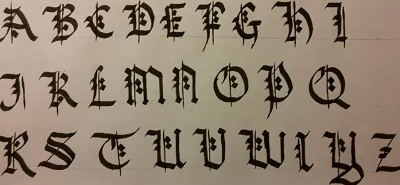In this post, I have put together a simple project about
how to write upper case Gothic style letters using a calligraphy pen. There are many variations of Gothic styles, and
here is an example, shown in the YouTube clip.
As you can see, the letterforms have extra details added to
enhance the appearance of the letters. I
used a broad nibbled calligraphy pen, black ink and I drew some guidelines to
keep the letters even. The letters were
about 6 nib widths high.
5 Steps
to Write Impressive Fancy Letters
Gothic Black Letters or Majuscule style letters are quite
tall, normally they are taller than the ascenders. In this example, I have drawn diamond shapes
using a broad nibbed pen within the letters, which are created by drawing short
strokes using a broad nibbed calligraphy pen.
They help to decorate the letters and make them appear grand. I have also drawn vertical thinner lines, decorations,
flairs and flicks drawn within the letters.
I held the pen nib at a constant 45 degree angle.
1) First,
map your work out by drawing faint straight lines on some paper using a ruler
and a hard nibbed sharp pencil
2) Draw
the outline of your capital letters with a faint pencil for guidelines
3) Holding
your broad nibbed calligraphy pen at a constant 45 degree angle, carefully draw
the letters as illustrated in the clip and draw the ticks at the vertical edges
of the letterforms
4) Holding
your calligraphy pen nib vertically, draw the vertical thin lines as
illustrated
5) Draw
the diamond shapes carefully by keeping your calligraphy pen nib at a 45 degree
angle and draw very short lines so they appear like diamond shapes. Draw them by the thin vertical lines within
the letters
Majuscule
Letters in Gothic Calligraphy
 |
| Gothic Upper-case Alphabet |
Some letters are quite wide, such as the letters S, Z, H,
A, and D. Other letterforms are based on
the shape of the letter O. They are quite
wide and fit within a square. These
letters are O, Q, C, G, and T. Narrow
letter are B, F, J, N, U, V, L and Y.
Simple
Hints to Writing Gothic Letters
- Use a broad nibbed
calligraphy pen
- Keep the nib angle
at a constant and steady 45 degree angle
- Draw guidelines
with a fine pencil before writing the Gothic letters
- Keep practicing
until you are happy with your calligraphy writing



